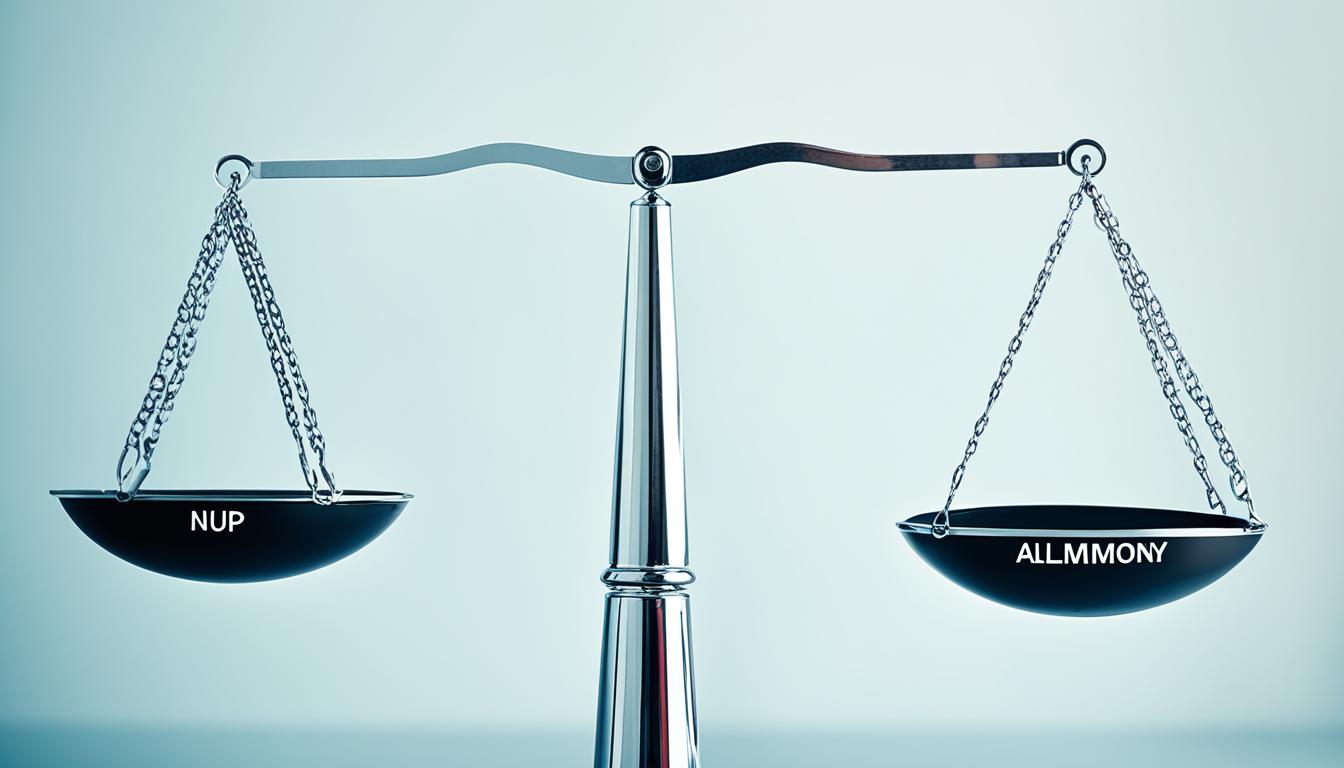In 2023, Governor Ron DeSantis implemented a new Florida alimony reform law that replaces permanent alimony with four new forms of alimony. This law brings significant changes to spousal support in Florida, impacting many individuals who rely on alimony for their financial stability.
Under the new law, courts now have the option to order alimony as a lump sum or periodic payments. Additionally, the legislation categorizes marriages into short-term, moderate-term, and long-term, each with different guidelines for the duration of the alimony award. Retirement rights and the modification process have also been addressed in this reform.
Key Takeaways:
- The Florida alimony reform law replaces permanent alimony with four types: temporary, bridge-the-gap, rehabilitative, and durational.
- Courts can now order alimony as a lump sum or periodic payments.
- Marriages are categorized as short-term, moderate-term, or long-term, determining the duration of the alimony award.
- The reform introduces retirement rights and a clear modification process.
- Consulting with a family law attorney is crucial to navigate the implications of this reform and potential modifications of alimony agreements.
The Journey of the Alimony Reform Bill
The Florida alimony reform bill, also known as SB 1416, embarked on a transformative journey through the legislative process, leading to significant changes in the state’s alimony system. Let’s take a closer look at the steps it took to become law.
Filing and Committees
On March 2, 2023, the Florida alimony reform bill was introduced and filed. This marked the beginning of its legislative journey. The bill was then referred to two key committees: the Committee on Fiscal Policy and the Rules Committees. These committees played a crucial role in reviewing and analyzing the proposed changes.
The bill underwent careful scrutiny and discussion within the Committee on Fiscal Policy and the Florida Senate Rules Committee. These committees evaluated the bill’s provisions, considering its potential impact on alimony awards in the state.
Calendar and Passage
After receiving favorable votes in the Committee on Fiscal Policy and the Florida Senate Rules Committee, the alimony reform bill advanced to the next stages of the legislative process. It was placed on the calendar, signifying its progression towards becoming law.
Both the Florida House of Representatives and the Florida Senate engaged in thorough debates and deliberations regarding the bill. The legislators considered the bill’s merits, the potential benefits, and the implications for alimony recipients and payers.
Ultimately, the reform bill passed both the Florida House of Representatives and the Florida Senate, solidifying its legislative support and underscoring the widespread acknowledgment of the need for change in the alimony system.
Governor’s Approval
On June 30, 2023, a momentous day arrived as Governor Ron DeSantis signed the Florida alimony reform bill into law. The Governor’s approval represented the final stage of the bill’s journey and affirmed the state’s commitment to modernizing the alimony framework.
With Governor Ron DeSantis’ signature, the Florida alimony reform bill officially became law, introducing significant alterations to alimony awards and providing clearer guidelines for the judicial system to follow.
Florida Alimony Reform Bill Journey
| Stage | Description |
|---|---|
| Filing | The bill is introduced and filed. |
| Committees | The bill is reviewed by the Committee on Fiscal Policy and the Rules Committees. |
| Calendar | The bill is placed on the calendar for further consideration. |
| Passage | The bill is debated and passed by the Florida House of Representatives and the Florida Senate. |
| Governor’s Approval | The bill is signed into law by Governor Ron DeSantis. |
Elimination of Permanent Alimony
The Florida alimony reform bill brings about a significant change in the way alimony is awarded in the state. The most notable change is the elimination of permanent alimony, which has been replaced with four new types of alimony:
- Temporary alimony
- Bridge-the-gap alimony
- Rehabilitative alimony
- Durational alimony
Under the new law, permanent alimony will no longer be awarded in Florida. Instead, courts now have the discretion to order one of the new alimony types based on the circumstances of each case.
These new alimony types provide more flexibility in determining the appropriate support for individuals going through divorce or separation. Let’s take a closer look at each of these new alimony types:
Temporary Alimony
Temporary alimony is awarded to provide immediate financial support to a spouse during the divorce process. It helps the receiving spouse maintain their standard of living and covers essential expenses while the divorce is pending.
Bridge-the-Gap Alimony
Bridge-the-gap alimony is designed to assist a spouse in transitioning from being married to being single. It helps cover short-term financial needs, such as housing or job training, to facilitate the spouse’s self-sufficiency.
Rehabilitative Alimony
Rehabilitative alimony aims to support a spouse in acquiring the necessary skills or education to become financially independent. It may cover the cost of educational or vocational training programs to help the spouse reenter the workforce.
Durational Alimony
Durational alimony provides financial support for a set period of time based on the length of the marriage. It aims to provide assistance to a spouse for a specific duration, acknowledging the importance of stability and gradual transition after divorce or separation.
The elimination of permanent alimony and the introduction of these new alimony types mark a significant shift in the approach to spousal support in Florida. The new law empowers courts to consider the unique circumstances of each case and order the appropriate type of alimony that best suits the needs of the parties involved.

Factors Considered in Alimony Determination
The Florida alimony reform law introduces a comprehensive set of factors that courts must consider when determining alimony awards. These factors aim to ensure that alimony decisions are fair, taking into account the specific circumstances of each case. From the need for support to the ability to pay, various elements are evaluated to establish the appropriate amount and duration of alimony.
Here are the key factors that courts consider:
- Need for support: The court evaluates the financial requirements of the party seeking support, taking into account their expenses and obligations.
- Ability to pay: The court assesses the financial capacity of the party responsible for paying alimony, considering their income, assets, and liabilities.
- Standard of living: The court considers the lifestyle the parties experienced during the marriage, aiming to maintain a similar standard of living after the divorce.
- Duration of the marriage: The length of the marriage is taken into account, as longer marriages may warrant different alimony arrangements than shorter ones.
- Age: The age of both parties is assessed, as it can impact their earning potential, retirement plans, and overall financial circumstances.
- Physical and mental condition: The health of the parties is considered, along with any related medical expenses and limitations.
- Income and resources: The court examines the income and financial resources of each party, including employment compensation, investments, and other sources of income.
- Earning capacities: The court evaluates the potential earning capacities of both parties based on their education, skills, work experience, and employability.
- Contribution to the marriage: The contributions made by each party to the marriage, both financial and non-financial, are taken into account.
- Child-rearing responsibilities: If child-rearing responsibilities significantly impact the party seeking support, the court considers the associated costs and adjustments needed.
- Equity and justice factors: The court may consider additional factors that promote equity and justice in the alimony determination process.
It is important to note that both the party seeking support and the party paying alimony have the burden of proof in demonstrating the need for support and the ability to pay.
Overall, these factors collectively guide the court in making just and equitable alimony determinations, ensuring that the financial arrangements appropriately reflect the parties’ circumstances and needs.

Categorizing Marriages and Alimony Types
The Florida alimony reform law categorizes marriages into three groups based on their length. The length of marriage plays a significant role in determining the type and duration of alimony awarded to the parties involved. It is essential to understand these categories and their implications when considering alimony obligations and entitlements.
Length of Marriage Categories
The categorization of marriages under the Florida alimony reform law is as follows:
| Category | Length of Marriage |
|---|---|
| Short-term | Less than 10 years |
| Moderate-term | Between 10 and 20 years |
| Long-term | 20 years or more |
These categories are used by the courts to determine the appropriate alimony type and duration based on the unique circumstances of each case.
Types of Alimony
According to the Florida alimony reform law, different types of alimony can be awarded based on the length of the marriage:
- Short-term marriages: For marriages lasting less than 10 years, bridge-the-gap alimony can be awarded for up to 2 years. Bridge-the-gap alimony assists with the transition from married life to being single, providing support to meet short-term financial needs.
- Moderate-term marriages: For marriages between 10 and 20 years, rehabilitative alimony may be awarded for up to 5 years. Rehabilitative alimony aims to help the receiving party become self-supportive through education, training, or other means.
- Long-term marriages: For marriages lasting 20 years or more, durational alimony can be awarded for a specific period determined by the court. Durational alimony provides financial support for a set period to assist the recipient in maintaining a similar standard of living as during the marriage.
It’s important to note that these guidelines are not absolute and may vary depending on the unique circumstances of each case. The court considers various factors to determine the duration and amount of alimony awarded.

Modifications of Alimony Agreements
The Florida alimony reform law recognizes that circumstances change over time, particularly when it comes to retirement. To ensure fairness and adaptability, the law allows for the modification of alimony agreements when the payor reaches the normal retirement age. This provision acknowledges that retired individuals may no longer have the same financial means to fulfill their alimony obligations.
The retirement age for alimony modification is determined based on guidelines provided by the Social Security Administration or the customary retirement age for the payor’s occupation. This ensures a standardized approach for determining when a modification can be considered.
When a request for alimony modification is made, the court takes various factors into consideration to make an informed decision. These factors include the age and health of the payor, the economic impact on the recipient, and the motivation and likelihood of the payor returning to work. By evaluating these factors, the court aims to provide clarity and a fair process for retirees navigating their alimony obligations.
It is important to note that alimony modification does not automatically result in reduction or termination. The court carefully examines the specific circumstances of each case to determine the appropriate course of action. This ensures that the interests of both parties and the original intent of the alimony agreement are considered.

| Factors Considered in Alimony Modification | Examples |
|---|---|
| Age and health of the payor | A payor who has reached the retirement age and has health issues that affect their ability to continue working. |
| Economic impact on the recipient | A recipient who relies heavily on alimony and would experience significant financial hardship if the alimony amount is not modified. |
| Motivation and likelihood of the payor returning to work | A payor who voluntarily retired but expresses a strong desire and capability to re-enter the workforce. |
These are just a few examples of factors that may be considered during the alimony modification process. Each case is unique, and the court carefully evaluates the specific circumstances presented before making a decision.
Concerns and Criticisms
The Florida alimony reform law has generated a range of concerns and criticisms, particularly from older women who receive permanent alimony. There are apprehensions that this law will have detrimental effects and contribute to the erosion of the institution of marriage. Critics argue that the elimination of permanent alimony may lead to financial devastation for recipients who relied on this support for their livelihood.
The retroactive effect of the law is also a point of contention. There are fears that existing permanent alimony agreements, which have been relied upon to make life decisions, may be modified under the new law. This potential retroactive effect raises uncertainties and may impact individuals who have made financial plans based on the stability of their alimony agreements.
“The removal of permanent alimony creates uncertainty for those who have relied on this support for years. It’s a disheartening development that disregards the financial security of older women.”
– Jane Simmons, Advocacy Group Representative
Opponents argue that the reform disregards the needs of individuals who dedicated their lives to raising children or supporting their spouses’ careers, often at the expense of their own professional growth. The elimination of permanent alimony may create financial hardships and imbalances, particularly for those who sacrificed their careers for the sake of their marriages.
These criticisms highlight the concerns surrounding the profound impact of the Florida alimony reform law on older women, the erosion of the institution of marriage, and the potential financial devastation caused by the elimination of permanent alimony. The retroactive effect on existing permanent alimony agreements further deepens the apprehensions and uncertainties associated with this legislative change.

Support and Opposition
The Florida alimony reform law has generated both support and opposition from different groups. Let’s take a closer look:
Support from Florida Family Fairness: Florida Family Fairness is one of the organizations that has expressed approval of the alimony reform bill. They believe that the elimination of permanent alimony and the clarification of retirement rights are positive changes that will benefit Florida families.
Emotional Clashes: As with any significant change, emotional clashes have arisen between those who support and those who oppose the reform. These clashes highlight the depth of feeling surrounding the issue and the impact it has on individuals.
“The removal of permanent alimony has the potential to significantly impact the lives of many older women who were depending on that support. It’s important to consider the potential financial devastation that this reform may cause.” – Spokesperson from the First Wives Advocacy Group
Opposition from First Wives Advocacy Group: The First Wives Advocacy Group has been vocal in their opposition to the alimony reform law. They express concerns about the financial impact on older women who receive permanent alimony and argue that the reform may contribute to the erosion of the institution of marriage.
Support from The Florida Bar’s Family Law Section: The Florida Bar’s Family Law Section, along with other supporters of alimony reform, has expressed their approval of the bill. They believe that the changes will help create a more equitable and fair system for both alimony recipients and payers.
While the alimony reform law has its share of supporters and opponents, it represents a significant shift in Florida’s approach to spousal support. The impact of these changes on individuals and families will undoubtedly continue to be a topic of discussion and debate.
Supporting Organizations
| Organization | Position |
|---|---|
| Florida Family Fairness | Support |
| The Florida Bar’s Family Law Section | Support |
Opposing Group
| Group | Position |
|---|---|
| First Wives Advocacy Group | Opposition |
Implications for Alimony Recipients and Payers
The Florida alimony reform law has significant implications for both alimony recipients and payers. With the elimination of permanent alimony, recipients who rely on this type of support may face financial challenges. The new law introduces four types of alimony – temporary, bridge-the-gap, rehabilitative, and durational – which provides courts with more flexibility in determining appropriate support.
For alimony payers, the reform law offers the opportunity to seek modifications to their alimony agreements when they reach the retirement age. This provision takes into account the payers’ changing financial circumstances as they approach retirement and allows for adjustments that align with their retirement plans.
However, it is important to consider potential legal fights that may arise during the modification process. While the reform law provides a framework for seeking modifications, disagreements and conflicts may still occur. Alimony recipients, especially those with medical expenses, express concerns about the financial impact of potential modifications on their well-being and stability.
To navigate these complexities, it is highly recommended for both alimony recipients and payers to consult with a family law attorney. A legal professional can provide individualized guidance based on specific circumstances, ensuring that the financial and legal implications of the reform law are fully understood and effectively addressed.
Key Implications:
- Financial challenges for alimony recipients relying on permanent alimony
- Flexibility in determining appropriate support with the introduction of four types of alimony
- Opportunity for alimony payers to seek modifications to their agreements at retirement age
- Potential for legal fights and conflicts during the modification process
- Concerns about the financial impact on recipients, especially those with medical expenses
- Importance of seeking guidance from a family law attorney for individualized advice
It is crucial for individuals involved in alimony cases to carefully consider and understand the implications of the Florida alimony reform law. By seeking legal advice and guidance, both recipients and payers can navigate the potential challenges and ensure their rights and financial well-being are protected.
Conclusion
The Florida alimony reform law, implemented in 2022-2023, has brought significant changes to the way alimony is awarded in the state. With the elimination of permanent alimony and the introduction of four new types, courts now have more flexibility in determining appropriate support for individuals going through a divorce.
One of the key aspects of the reform is the inclusion of retirement rights. The law now provides a clear process for modifying alimony agreements when the payor reaches the normal retirement age. Factors such as the payor’s health, occupation, and economic impact on the recipient are considered during the modification process.
It is crucial for individuals involved in alimony cases to understand the impact of these changes. Seeking legal advice is highly recommended to navigate any potential modifications or disputes related to alimony awards. By understanding the implications of the Florida alimony reform law, individuals can ensure a fair resolution and protect their rights.
FAQ
What is the Florida alimony reform bill?
The Florida alimony reform bill is a piece of legislation that was signed into law by Governor Ron DeSantis on June 30, 2023. It significantly impacts the way alimony is awarded in Florida, replacing permanent alimony with four types of alimony: temporary, bridge-the-gap, rehabilitative, and durational.
What factors are considered when determining alimony awards in Florida?
Courts in Florida consider multiple factors when determining alimony awards, including the parties’ need for support, their ability to pay, the standard of living during the marriage, the duration of the marriage, and the contributions made to the marriage. Additionally, the age and health of both parties, their income and resources, earning capacities, child-rearing responsibilities, and any other factors that promote equity and justice are taken into account.
How are marriages categorized under the Florida alimony reform law?
Marriages in Florida are categorized into three groups based on their length. A short-term marriage is defined as lasting less than 10 years, a moderate-term marriage is between 10 and 20 years, and a long-term marriage is 20 years or more. Each category has different guidelines for the duration of the alimony award.
Can alimony agreements be modified under the Florida alimony reform law?
Yes, alimony agreements can be modified under the Florida alimony reform law when the payor reaches the normal retirement age. The court considers factors such as the age and health of the payor, the economic impact on the recipient, and the motivation and likelihood of the payor returning to work.
What are the concerns and criticisms of the Florida alimony reform law?
The Florida alimony reform law has faced concerns and criticisms from certain groups, particularly older women who receive permanent alimony. Some argue that the law will cause financial devastation and contribute to the erosion of the institution of marriage. Retroactive effect is also a point of contention, as opponents fear that existing permanent alimony agreements may be modified under the new law, affecting individuals who have made decisions based on those agreements.
Who supports and opposes the Florida alimony reform law?
The Florida alimony reform law has garnered support from organizations such as Florida Family Fairness, which believes that the elimination of permanent alimony and the clarification of retirement rights are positive changes for Florida families. However, opposition from groups like the First Wives Advocacy Group has been vocal, with concerns about the financial impact on older women. The Florida Bar’s Family Law Section and other supporters of alimony reform have also expressed their approval of the bill.
What are the implications of the Florida alimony reform law for alimony recipients and payers?
The Florida alimony reform law has implications for both alimony recipients and payers. Recipients who rely on permanent alimony may face financial challenges due to the elimination of this type of support. Payers, on the other hand, may have the opportunity to seek modifications to their alimony agreements when they reach the retirement age. However, concerns have been raised about the potential for legal fights and the financial impact on recipients, particularly those with medical expenses. It is recommended to consult with a family law attorney for individualized guidance.
What are the significant changes brought about by the Florida alimony reform law?
The most significant change brought about by the Florida alimony reform law is the elimination of permanent alimony. Instead, the law introduces four new types of alimony: temporary, bridge-the-gap, rehabilitative, and durational. Permanent alimony will no longer be awarded in Florida, and courts will have the discretion to order one of the new alimony types based on the circumstances of each case.
How does the Florida alimony reform law impact alimony determination?
The Florida alimony reform law requires courts to consider multiple factors when determining alimony awards. These factors include the need for support and the ability to pay, the parties’ standard of living during the marriage, the duration of the marriage, the age and health of both parties, their income and resources, earning capacities, contributions made to the marriage, child-rearing responsibilities, and any additional factors that promote equity and justice. Both the party seeking support and the party paying support have the burden of proof in demonstrating the need for support and the ability to pay.
What are the alimony types introduced by the Florida alimony reform law?
The Florida alimony reform law introduces four new types of alimony: temporary alimony, bridge-the-gap alimony, rehabilitative alimony, and durational alimony. Each type serves a specific purpose and can be awarded based on the circumstances of the case and the length of the marriage.
What is the journey of the Florida alimony reform bill?
The Florida alimony reform bill, also known as SB 1416, went through various stages in the legislative process, including being referred to the Committee on Fiscal Policy and the Rules Committees. It received favorable votes in the Committee on Fiscal Policy and the Florida Senate Rules Committee, and ultimately passed both the Florida House of Representatives and the Florida Senate. On June 30, 2023, Governor Ron DeSantis signed the bill into law.











